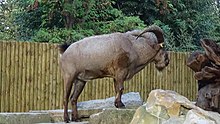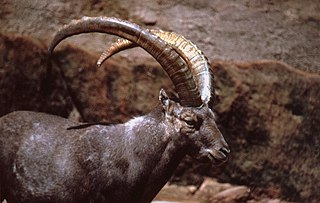
An ibex is any of several species of wild goat , distinguished by the male's large recurved horns, which are transversely ridged in front. Ibex are found in Eurasia, North Africa and East Africa. The name ibex comes from Latin, borrowed from Iberian or Aquitanian, akin to Old Spanish bezerro "bull", modern Spanish becerro "yearling". Ranging in height from 70 to 110 centimetres (27–43 in) and weighing 90 to 120 kilograms (200–270 lb), ibex can live up to 20 years. Two closely related varieties of goats found in the wild are not usually called ibex: the markhor and the feral goat.

The Alpine ibex, also known as the steinbock, bouquetin, or simply ibex, is a species of wild goat that lives in the mountains of the European Alps. It is a sexually dimorphic species: males are larger and carry longer, curved horns than females. Its coat colour is typically brownish grey. Alpine ibex tend to live in steep, rough terrain near the snow line. They are also social, although adult males and females segregate for most of the year, coming together only to mate. Four distinct groups exist; adult male groups, female-offspring groups, groups of young individuals, and mixed-sex groups.

Capra is a genus of mammals, the goats, composed of up to nine species, including the markhor and many species known as ibexes. The domestic goat is a domesticated species derived from the wild goat. Evidence of goat domestication dates back more than 8,500 years.
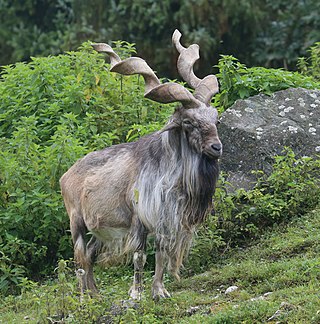
The markhor is a large Capra species native to Central Asia, the Karakoram, and the Himalayas. It is listed on the IUCN Red List as Near Threatened since 2015.

The wild goat is a wild goat species, inhabiting forests, shrublands and rocky areas ranging from Turkey and the Caucasus in the west to Turkmenistan, Afghanistan and Pakistan in the east. It has been listed as near threatened on the IUCN Red List and is threatened by destruction and degradation of habitat.

The East Caucasian tur, also known as the Daghestani tur, is a mountain-dwelling caprine living in the eastern half of the Greater Caucasus mountains, in Azerbaijan, Georgia, and European Russia. It inhabits rough mountainous terrain, where it eats mainly grasses and leaves. It is listed as near threatened on the IUCN Red List.

The gemsbok or South African oryx is a large antelope in the genus Oryx. It is native to the extremely dry, arid regions of Southern Africa; notably, the Kalahari and Namib Desert. Some authorities formerly classified the East African oryx as a subspecies.

The walia ibex is a vulnerable species of ibex. It is sometimes considered an endemic subspecies of the Alpine ibex. Threats against the species include habitat loss, poaching, and restricted range; only about 500 individuals survived in the mountains of Ethiopia, concentrated in the Semien Mountains, largely due to past poaching and habitat depletion. If the population were to increase, the surrounding mountain habitat would be sufficient to sustain only 2,000 ibex. The adult walia ibex's only known wild predator is the hyena. However, young ibex are often hunted by a variety of fox and cat species. The ibex are members of the goat family, and the walia ibex is the southernmost of today's ibexes. In the late 1990s, the walia ibex went from endangered to critically endangered due to the declining population. The walia ibex is also known as the Abyssinian ibex. Given the small distribution range of the Walia ibex in its restricted mountain ecosystem, the presence of a large number of domestic goats may pose a serious threat that can directly affect the survival of the population.

The Caucasus mixed forests is a temperate broadleaf and mixed forests ecoregion in the Caucasus Mountains, as well as the adjacent Lesser Caucasus range and the eastern end of the Pontic Mountains.
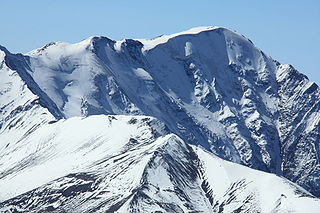
Shahdag National Park — is a national park of Azerbaijan. It was established on an area of 115,900 hectares (1,159 km2) in the Quba Rayon, Qusar Rayon, İsmayıllı Rayon, Qəbələ Rayon, Oğuz Rayon and Şamaxı Rayon administrative districts on December 8, 2006. It was enlarged by presidential decree on July 8, 2010 from 115,900 hectares (1,159 km2) to 130,508.1 hectares (1,305.081 km2).

The Asian ibex, also known using regionalized names as the Siberian ibex,Altai ibex, Central Asian ibex, Gobi ibex, Himalayan ibex, Mongolian ibex or Tian Shan ibex, is a polytypic species of ibex. It lives in central Asia, it is by far the most widely distributed species in the genus Capra and Asian ibex is listed as Near Threatened in view of the prevalence of threats, low densities in most areas and overall population decline, but available data are of insufficient reliability and area coverage. It has formerly been treated as a subspecies of the Alpine ibex, and whether it is a single species or a complex of distinct units that stand out as genetically differentiated at species level is still not entirely clear. It is the longest and heaviest member of the genus Capra, though its shoulder height is surpassed by the markhor.

The Caucasian salamander is a species of stream-dwelling salamander in the family Salamandridae. This is a salamander of medium size, with a thin, elongated body. It is a relict species, endemic to the south-western Caucasus, in Georgia and Turkey. The subspecies M. c. janashvilii is found at Mt. Mtirala near Batumi and probably along the Black Sea coast.

The bezoar ibex is a wild goat subspecies that is native to the montane forested areas in the Caucasus and the Zagros Mountains.
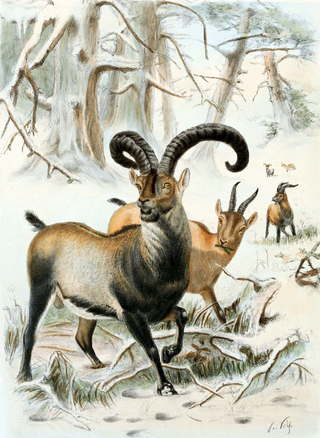
The Pyrenean ibex, Aragonese and Spanish common name bucardo, Basque common name bukardo, Catalan common name herc and French common name bouquetin, was one of the four subspecies of the Iberian ibex or Iberian wild goat, a species endemic to the Pyrenees. Pyrenean ibex were most common in the Cantabrian Mountains, Southern France, and the northern Pyrenees. This species was common during the Holocene and Upper Pleistocene, during which their morphology, primarily some skulls, of the Pyrenean ibex was found to be larger than other Capra subspecies in southwestern Europe from the same time.

Pshav-Khevsureti National Park is in Dusheti Municipality, Mtskheta-Mtianeti region of Georgia. Park has been established by direct involvement of World Wide Fund for Nature.
Capra dalii is a fossil species of goat discovered in Georgia in 2006. It is named for the Georgian goddess Dali, who was considered the guardian of hoofed animals such as ibexes and goats. Fragments of C. dalii fossils were first located at the Dmanisi archaeological site, and are believed to be related to the west Caucasian tur, Capra caucasica. The species is believed to have existed during the Early Pleistocene, around 1.76 million years ago, making it the oldest known example of the Capra genus.
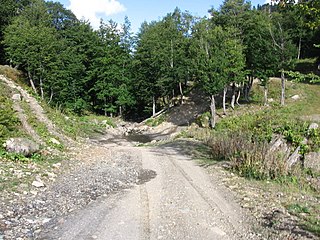
Pskhu-Gumista Strict Nature Reserve is a protected area in the Sukhumi District of Abkhazia, Georgia. The primary goal of the reserve is to protect flora and fauna of the area, including the surrounding mountainous region.
